morioc
AH fanatic
Pami*, The Mythe
*Bongo
by Philippe Aillery for Christophe Morio, Article originally published in Connaissance de la Chasse


Professional hunter, Christophe Morio imposes himself also as an experienced naturalist. He is passionate of the entire fauna. Among the latter, a species with whom he often interacts with in Central African republic (CAR) makes his eyes shine: the Bongo.
Click on thumbnail to view video

Tell us about your first encounter with the Bongo?
Christophe Morio: That first vision was fleeting. It began in the late 2005 in the region of Ouadda, along the river Bougnou, in the north-eastern part of Central Africa. We found numerous tracks of Bongos, both on the salt pans areas and at the heart of the densest Bakos. Accompanied by a hunter friend and his wife, we turned our sights on the trail of a big male that we did not let go for five days after which we glimpsed the animal in a small clearing. My hunter tried shooting in vain. I would stand on my hunger and the antelope kept in my eyes all its' mystery. This too brief meeting sharpened my curiosity over time. I soon made it an imperative. I wanted more than anything to observe this unattainable grail in good conditions.

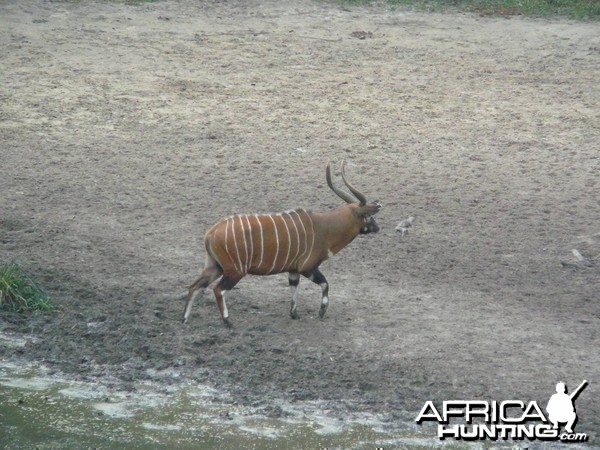
And since this first encounter?
I had to wait until the month of November 2006, at the beginning of the dry season, to finally appease my thirst of the discovery of the Pami (Bongo in the Banda language). At that time I was working at the planning of salt pans and the construction of watchtowers in the area of Idongo-Da-Bangoran held by Matthieu Laboureur. By the way salt pans are excellent in revealing of the fauna present in the vicinity. By the way I picked up on these different locations a multitude of tracks of Buffaloes, Bushbucks, Duikers, Giant Forest Hogs and, to my delight, Bongos. It was also during this work that I finally had my first two real contact with these majestic antelopes, first with a lone male, then with a group which I obviously immortalized on film.

Big Bongo in the salt pan, and below the record of Christophe.
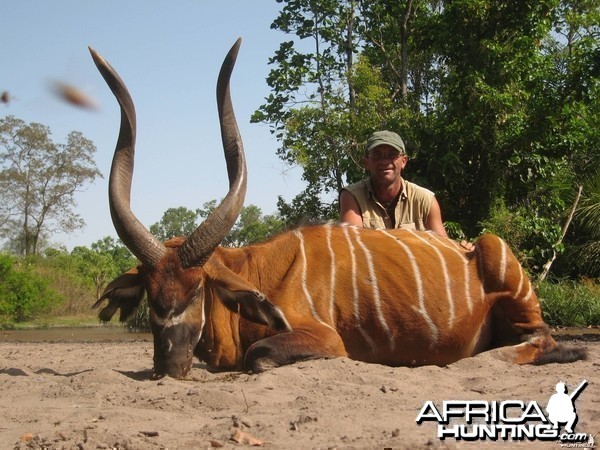
Bongo 36 2/8 inches
Then there was the first harvested animal and many other encounters...
Indeed, in March of 2007, I had the great good fortune to have a South African hunter take my first Bongo on the salt pans "Batou". And what a Bongo! A very old and emaciated monster which none of the members of the team working on the territory was aware of.
The trophy carried by this animal reached 91.5 centimeters (36.02 inches). Which makes him the world record according to Rowland Ward method of measurement and ranks him at the 5th place in SCI world record book. Even in my wildest dreams, I could have never imagined such a harvest. Since this coronation, I watched, harvested and mainly photographed hundreds of Bongos at Matthieu Laboureur. In 2009, I counted exactly 131.
In 2010, I reported 92. Note that the best times to observe these antelopes from a blind are the months of January and April, when the salt pans are flooded. At Idongo-Da-Bangoran, we have a quota of 6 animals per season. We are therefore regularly in search of this species and therefore we see it quite often.

Aside from the CAR, which countries are home to this species?
The geographic range of the Bongo extends from Sierra Leone to Congo to Kenya in the forests of the Aberdare Mountain Range. The antelope has there a darker color than its cousins in West and Central Africa. The biggest paradox is that in the north-central CAR, right where we hunt Bongo, he is not classified / listed... in the books. Funny and surprising, right? Remember that only two African countries allow hunting of Bongo with a licensed, CAR and Cameroon.
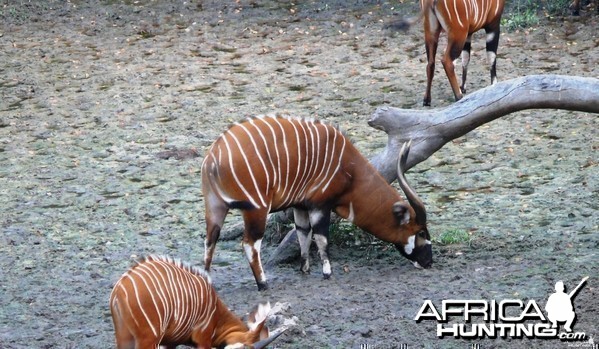
Each animal wears a set of stripes of its own and may also differ from one coat to another.
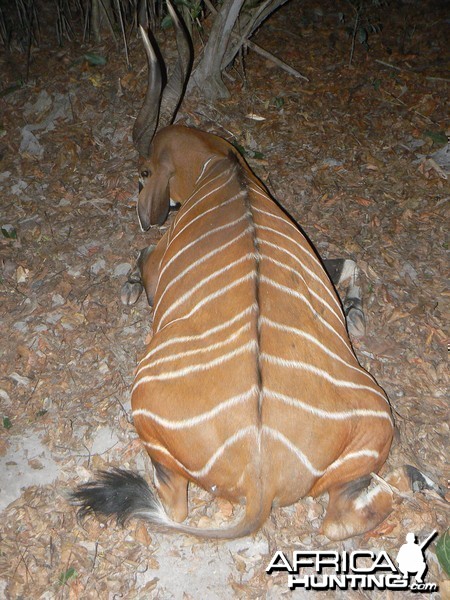
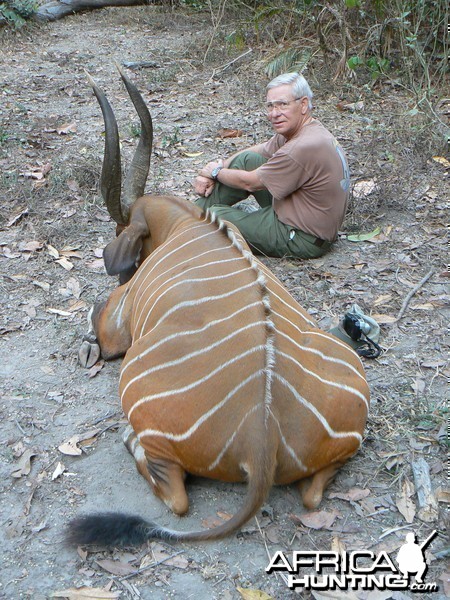
What is its preferred habitat?
The Bongo is primarily a forest species. It loves the dense cover. It likes the gallery forests located along major rivers from which it rejoins the secondary bakos where it finds food and tranquility. In the dry season, it leaves only very rarely these havens of peace, which did not prevent it from moving a lot. I think, on the other hand during the rainy season, when the straw is high, it does not hesitate to linger in savannah.
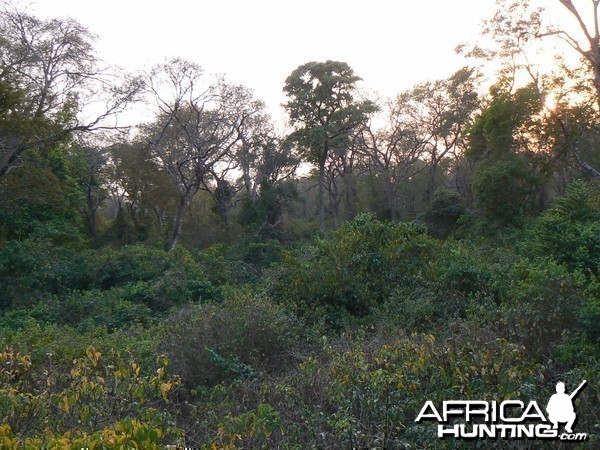

What can you tell us about the manners of this discrete antelope?
It is a gregarious and non-territorial animal that has for main interest salt pans. His sense of smell, hearing and sight are highly developed. Groups consisting of 5 to 25 individuals, have a matriarchal structure which can consist a large male and two subadult males. Old males have a tendency to be solitary.
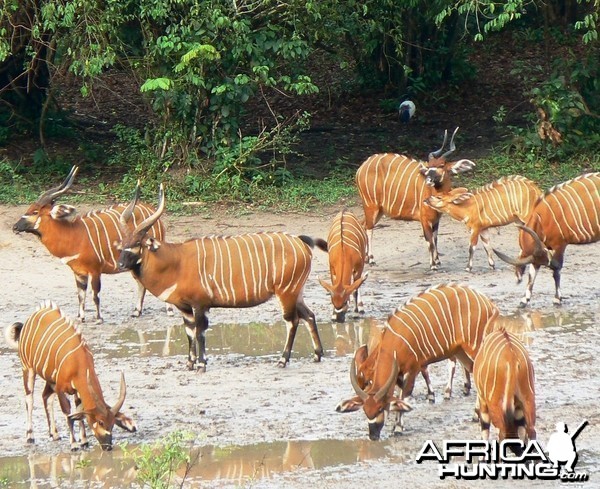
The Bongo is rather active in the twilight hours and at night. The rest of the day, it ruminates under cover. Shy, suspicious, furtive, it rears its crest at the slightest alarm and escape at full gallop, muzzle high and horns elongated on the neckline. In a group, they appear calmer, less fearful and show some aggression between them, presumably to establish their rank. The Bongo makes several cries depending on its mood. It grunts, moos, and like the Bushbuck, Sitatunga or the Kudu, it barks.
It is very common to hear the sound of the Bongo's manifestations. I will end this chapter by saying that it is a selective grazer that looks in priority for plants with high protein levels. It consumes leaves, young shoots, bark, flowers, fruits or roots he gets through his prehensile tongue and also through his horns it uses as a tool. The mineral salts that it finds in the ashes of burnt trees or at the salt pans are important to its' good development.
Click on thumbnail to view video

A few words on its morphology?
It displays an average height at withers of 125 centimeters (49.2 inches) for a weight of 220 to 400 kilograms (485 to 880 pounds). Its coat is dark red / orange. It darkens in older males. The female is more orange than the male. This coat is striped with 11 to 14 vertical white stripes that serve as camouflage. Sometimes, but it is not systematic, the number of stripes on the animal is not identical from one side to the other. It wears a white mark on his chest, a chevron between the eyes and two white spots on the cheeks which can sometimes merge to make one. The tail is very bushy and the ears very wide. The lyre-shaped horns of brown amber color with white tips are worn by both sexes.
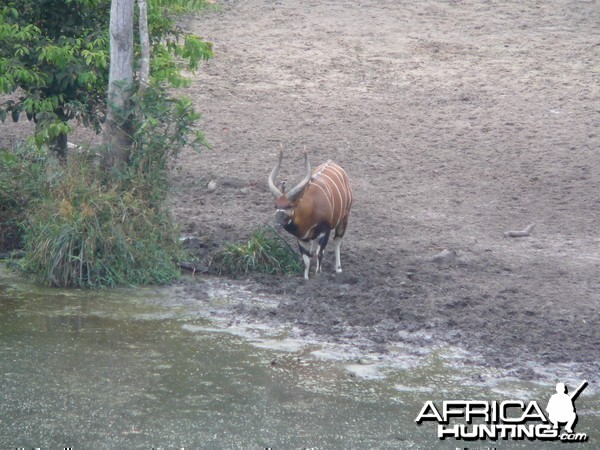

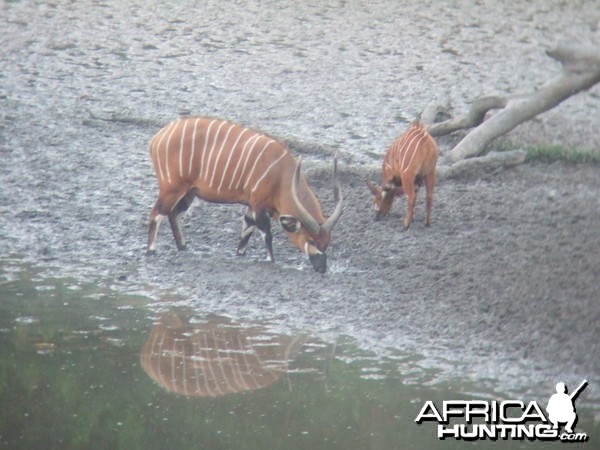
What about reproduction?
The bongo reach sexual maturity between the age of 24 and 27 months. The female is receptive every 3 weeks during 3 days. It brings to life a little one after a gestation of nine months. Twin births are extremely rare.
Your photos show animals with very different horns and sometimes even atypical. How is this wide disparity explained?
Indeed, there are many differences among the Bongo's horns. We can observe horns that are parallel or flared, and convolutions of varying depth. In some animals, the horns even come to intersect. This phenomenon occurs mainly in females. This wide disparity of trophies is still a mystery to me.

Weighing up to 400 kilograms (880 pounds), the Bongo is the largest forest antelope. They are mostly females who sport "strange" horns that meet.

Another female with impressive horns.
Which morphological signs enable for sure to distinguish the male from the female?
As in all species where males and females carry horns, the difference between the two sexes is not easy at first sight. Apart from the male specific attributes (which are almost invisible in the bongo in normal position), we must remember that it has a body about one third larger than females.


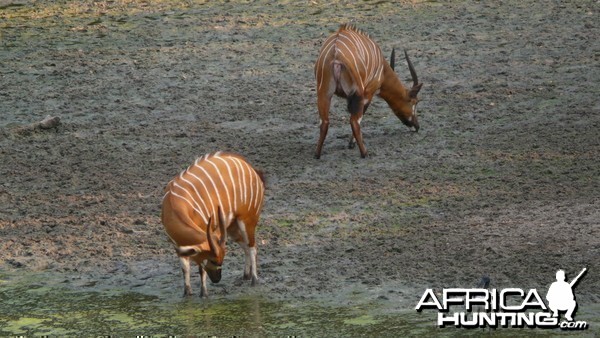
The most impressive is the large volume of the neck in older males. The horns are also much longer and bases thicker (25 to 27 centimeters (9.84 to 10.63 inches). Within a group, it can be spotted by his behavior and attitude of dominence. Whe it comes to the lone ones, I suggest caution as all subjects are not lone males. I have observed females alone.
How do you hunt bongo CAR?
Depending on the season, wet or dry, I use hunting methods such as tracking, quiet flushing, encounter or from a strategically located hide. This latter method of hunting gives obviously excellent results. This is probably not the one I cherish the most, but we must recognize that it can assess and select precisely the trophies.

Trail access in a very humid environment.


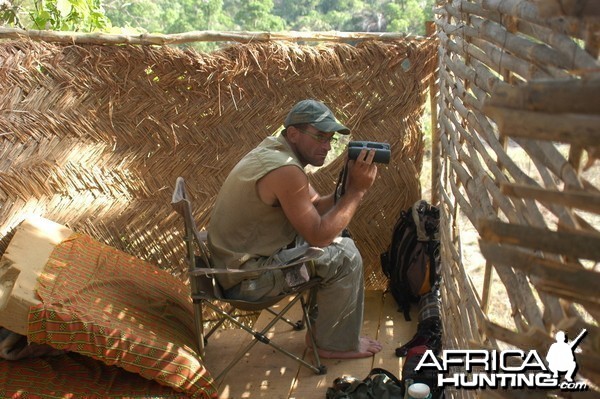
Dry elevated hide.

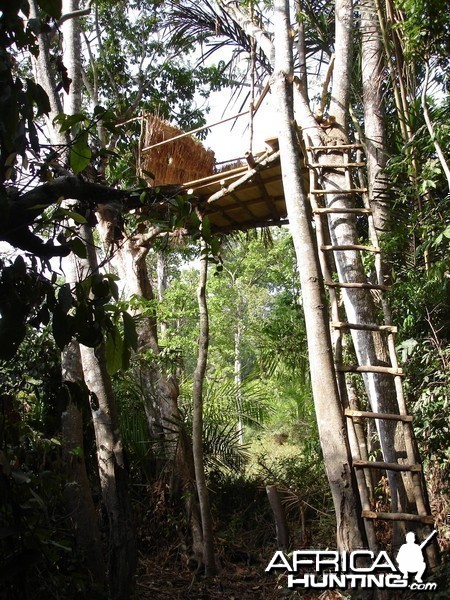


What is your opinion about hunting with dogs?
I never hunted the Bongo with dogs, so I find it difficult to give an opinion. However, a priori, that attracts me. The man and the dog are, since the dawn of time, inseparable in many hunting activities. So why not behind the Bongos?
Your fondest memory hunting Bongo?
It is actually two successive meetings. So, one early morning, I had a client shoot a superb Bongo of 87 centimeters (34.25 inches). After taking the trophy photos and cutting up the animal, it was then about 8:00, I dragged my hunter to a hide overlooking a salt pan where a group of 19 heads was waiting for us, we took so many pictures with our cameras. This morning remains without a doubt one of my greatest memories.
Click on thumbnail to view video

What is a good bongo?
I must first specify that the track of a large male is on average 9 to 10 centimeters (inches 3.5 to 3.9) wide. This provides a sound basis for initiating a search or not. Also, be aware that the horns of the bongo are growing rapidly. They can reach 65 centimeters (25.6 inches) in 3 years. It is considered as good an animal carrying 70 centimeters (27.6 inches) and as big an animal carrying 80 centimeters (31.5 inches). While hunting, it is rare to have time to dwell on the shape of the trophy. The best for me are those whose horns flare outwards. So when an animal is a big body, a thick neck, the tips of horns very white and the rest of a nice amber color, it's a good trophy, certainly a mature male, or older.

Bongo track.
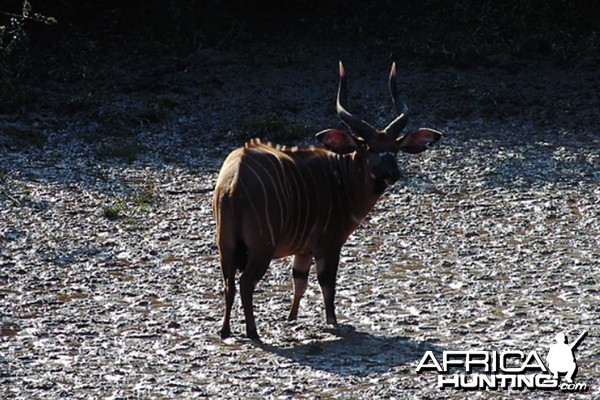

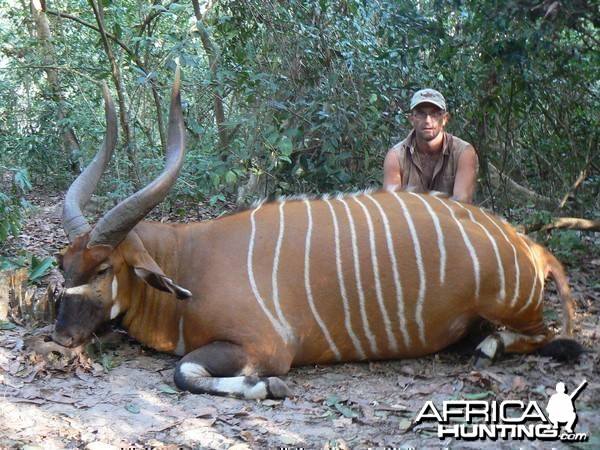
Bongo 34 1/8 inches

Bongo 34 1/2 inches

Bongo 28 inches
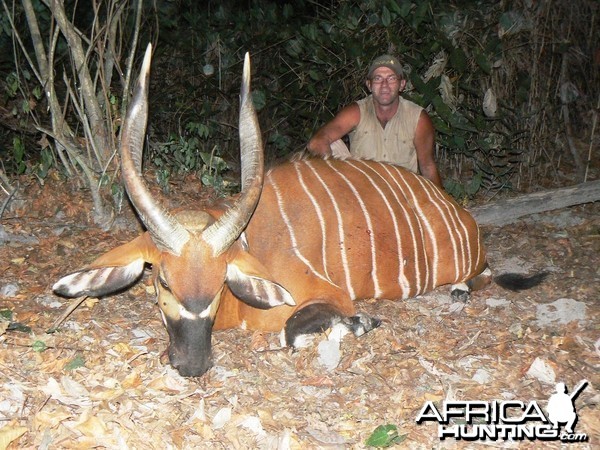
Bongo 26 inches
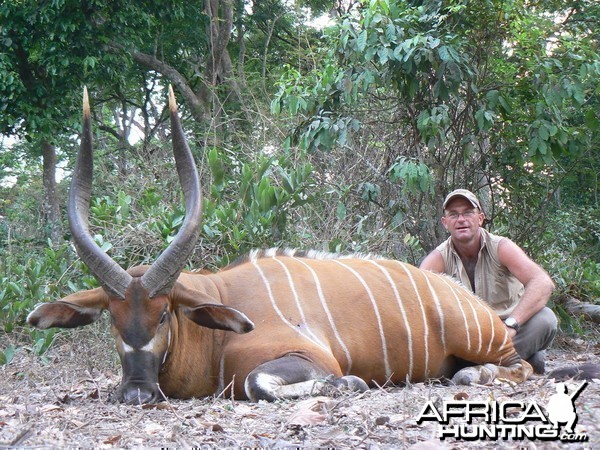
Bongo 30.5 inches
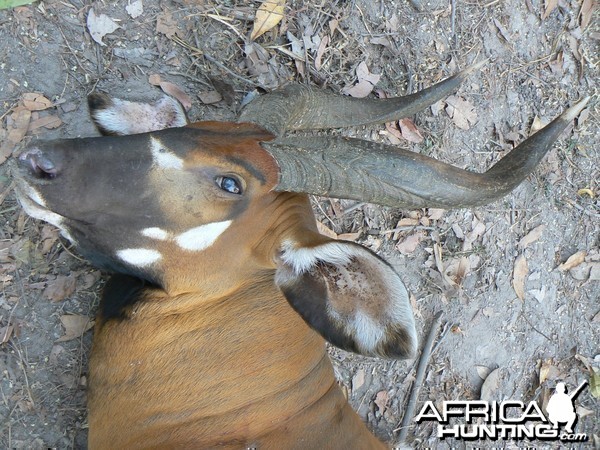


Bongo droppings.
Its situation in CAR
Despite recurring poaching (rifle, snare), the species blooms in all of the central African hunting areas where it can be found. Most hunting outfitters have also seen an increase in their quotas and their results. My first explanation, and it is only my opinion, has to do with the extermination of Elephants by Sudanese and local poachers. Without Elephants, the forest closes onto itself, thickens and provides the necessary tranquility to the fearful Bongo. Fewer Elephants (due to poaching) and a mild weather allows for a dense forest to sustain, even its development.
Secondly, I think the hunting concession owners took notice of this surge of animals which they bear special attention to. They have strengthened the anti poaching efforts and anti diamond to protect sites for the antelope and improved or increased the salt pans which hold quite well these animals. I am convinced that a Bongo of a meter (a yard) will be taken in the near future.
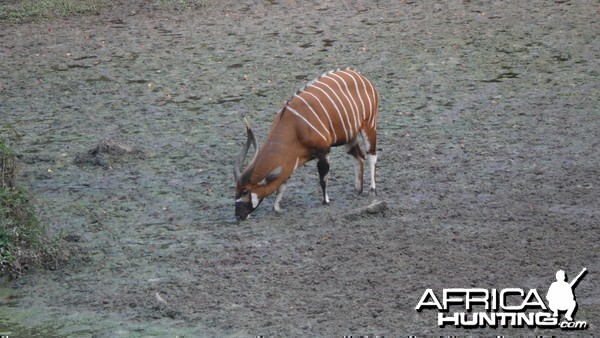
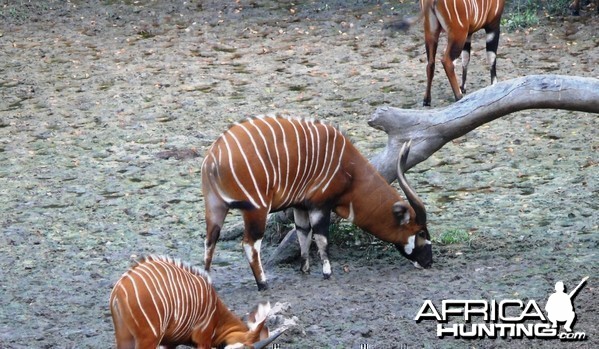

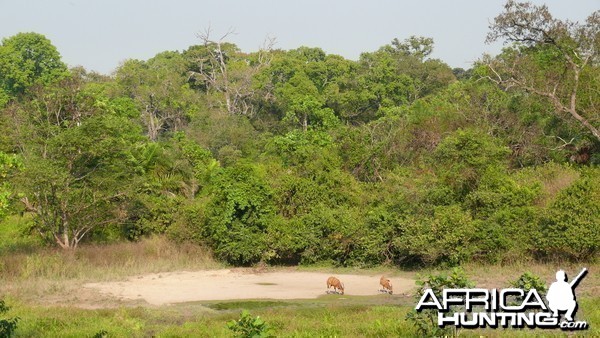


The final word...
Animal of the twilight, the Bongo wears a coat of light. Its beauty is a reflection of his quest, majestic and unforgettable. An experience to live without moderation...

*Bongo
by Philippe Aillery for Christophe Morio, Article originally published in Connaissance de la Chasse

Professional hunter, Christophe Morio imposes himself also as an experienced naturalist. He is passionate of the entire fauna. Among the latter, a species with whom he often interacts with in Central African republic (CAR) makes his eyes shine: the Bongo.
Click on thumbnail to view video

Tell us about your first encounter with the Bongo?
Christophe Morio: That first vision was fleeting. It began in the late 2005 in the region of Ouadda, along the river Bougnou, in the north-eastern part of Central Africa. We found numerous tracks of Bongos, both on the salt pans areas and at the heart of the densest Bakos. Accompanied by a hunter friend and his wife, we turned our sights on the trail of a big male that we did not let go for five days after which we glimpsed the animal in a small clearing. My hunter tried shooting in vain. I would stand on my hunger and the antelope kept in my eyes all its' mystery. This too brief meeting sharpened my curiosity over time. I soon made it an imperative. I wanted more than anything to observe this unattainable grail in good conditions.
And since this first encounter?
I had to wait until the month of November 2006, at the beginning of the dry season, to finally appease my thirst of the discovery of the Pami (Bongo in the Banda language). At that time I was working at the planning of salt pans and the construction of watchtowers in the area of Idongo-Da-Bangoran held by Matthieu Laboureur. By the way salt pans are excellent in revealing of the fauna present in the vicinity. By the way I picked up on these different locations a multitude of tracks of Buffaloes, Bushbucks, Duikers, Giant Forest Hogs and, to my delight, Bongos. It was also during this work that I finally had my first two real contact with these majestic antelopes, first with a lone male, then with a group which I obviously immortalized on film.
Big Bongo in the salt pan, and below the record of Christophe.
Bongo 36 2/8 inches
Then there was the first harvested animal and many other encounters...
Indeed, in March of 2007, I had the great good fortune to have a South African hunter take my first Bongo on the salt pans "Batou". And what a Bongo! A very old and emaciated monster which none of the members of the team working on the territory was aware of.
The trophy carried by this animal reached 91.5 centimeters (36.02 inches). Which makes him the world record according to Rowland Ward method of measurement and ranks him at the 5th place in SCI world record book. Even in my wildest dreams, I could have never imagined such a harvest. Since this coronation, I watched, harvested and mainly photographed hundreds of Bongos at Matthieu Laboureur. In 2009, I counted exactly 131.
In 2010, I reported 92. Note that the best times to observe these antelopes from a blind are the months of January and April, when the salt pans are flooded. At Idongo-Da-Bangoran, we have a quota of 6 animals per season. We are therefore regularly in search of this species and therefore we see it quite often.
Aside from the CAR, which countries are home to this species?
The geographic range of the Bongo extends from Sierra Leone to Congo to Kenya in the forests of the Aberdare Mountain Range. The antelope has there a darker color than its cousins in West and Central Africa. The biggest paradox is that in the north-central CAR, right where we hunt Bongo, he is not classified / listed... in the books. Funny and surprising, right? Remember that only two African countries allow hunting of Bongo with a licensed, CAR and Cameroon.
Each animal wears a set of stripes of its own and may also differ from one coat to another.
What is its preferred habitat?
The Bongo is primarily a forest species. It loves the dense cover. It likes the gallery forests located along major rivers from which it rejoins the secondary bakos where it finds food and tranquility. In the dry season, it leaves only very rarely these havens of peace, which did not prevent it from moving a lot. I think, on the other hand during the rainy season, when the straw is high, it does not hesitate to linger in savannah.
What can you tell us about the manners of this discrete antelope?
It is a gregarious and non-territorial animal that has for main interest salt pans. His sense of smell, hearing and sight are highly developed. Groups consisting of 5 to 25 individuals, have a matriarchal structure which can consist a large male and two subadult males. Old males have a tendency to be solitary.
The Bongo is rather active in the twilight hours and at night. The rest of the day, it ruminates under cover. Shy, suspicious, furtive, it rears its crest at the slightest alarm and escape at full gallop, muzzle high and horns elongated on the neckline. In a group, they appear calmer, less fearful and show some aggression between them, presumably to establish their rank. The Bongo makes several cries depending on its mood. It grunts, moos, and like the Bushbuck, Sitatunga or the Kudu, it barks.
It is very common to hear the sound of the Bongo's manifestations. I will end this chapter by saying that it is a selective grazer that looks in priority for plants with high protein levels. It consumes leaves, young shoots, bark, flowers, fruits or roots he gets through his prehensile tongue and also through his horns it uses as a tool. The mineral salts that it finds in the ashes of burnt trees or at the salt pans are important to its' good development.
Click on thumbnail to view video

A few words on its morphology?
It displays an average height at withers of 125 centimeters (49.2 inches) for a weight of 220 to 400 kilograms (485 to 880 pounds). Its coat is dark red / orange. It darkens in older males. The female is more orange than the male. This coat is striped with 11 to 14 vertical white stripes that serve as camouflage. Sometimes, but it is not systematic, the number of stripes on the animal is not identical from one side to the other. It wears a white mark on his chest, a chevron between the eyes and two white spots on the cheeks which can sometimes merge to make one. The tail is very bushy and the ears very wide. The lyre-shaped horns of brown amber color with white tips are worn by both sexes.
What about reproduction?
The bongo reach sexual maturity between the age of 24 and 27 months. The female is receptive every 3 weeks during 3 days. It brings to life a little one after a gestation of nine months. Twin births are extremely rare.
Your photos show animals with very different horns and sometimes even atypical. How is this wide disparity explained?
Indeed, there are many differences among the Bongo's horns. We can observe horns that are parallel or flared, and convolutions of varying depth. In some animals, the horns even come to intersect. This phenomenon occurs mainly in females. This wide disparity of trophies is still a mystery to me.
Weighing up to 400 kilograms (880 pounds), the Bongo is the largest forest antelope. They are mostly females who sport "strange" horns that meet.
Another female with impressive horns.
Which morphological signs enable for sure to distinguish the male from the female?
As in all species where males and females carry horns, the difference between the two sexes is not easy at first sight. Apart from the male specific attributes (which are almost invisible in the bongo in normal position), we must remember that it has a body about one third larger than females.
The most impressive is the large volume of the neck in older males. The horns are also much longer and bases thicker (25 to 27 centimeters (9.84 to 10.63 inches). Within a group, it can be spotted by his behavior and attitude of dominence. Whe it comes to the lone ones, I suggest caution as all subjects are not lone males. I have observed females alone.
How do you hunt bongo CAR?
Depending on the season, wet or dry, I use hunting methods such as tracking, quiet flushing, encounter or from a strategically located hide. This latter method of hunting gives obviously excellent results. This is probably not the one I cherish the most, but we must recognize that it can assess and select precisely the trophies.
Trail access in a very humid environment.
Dry elevated hide.
What is your opinion about hunting with dogs?
I never hunted the Bongo with dogs, so I find it difficult to give an opinion. However, a priori, that attracts me. The man and the dog are, since the dawn of time, inseparable in many hunting activities. So why not behind the Bongos?
Your fondest memory hunting Bongo?
It is actually two successive meetings. So, one early morning, I had a client shoot a superb Bongo of 87 centimeters (34.25 inches). After taking the trophy photos and cutting up the animal, it was then about 8:00, I dragged my hunter to a hide overlooking a salt pan where a group of 19 heads was waiting for us, we took so many pictures with our cameras. This morning remains without a doubt one of my greatest memories.
Click on thumbnail to view video

What is a good bongo?
I must first specify that the track of a large male is on average 9 to 10 centimeters (inches 3.5 to 3.9) wide. This provides a sound basis for initiating a search or not. Also, be aware that the horns of the bongo are growing rapidly. They can reach 65 centimeters (25.6 inches) in 3 years. It is considered as good an animal carrying 70 centimeters (27.6 inches) and as big an animal carrying 80 centimeters (31.5 inches). While hunting, it is rare to have time to dwell on the shape of the trophy. The best for me are those whose horns flare outwards. So when an animal is a big body, a thick neck, the tips of horns very white and the rest of a nice amber color, it's a good trophy, certainly a mature male, or older.
Bongo track.
Bongo 34 1/8 inches
Bongo 34 1/2 inches
Bongo 28 inches
Bongo 26 inches
Bongo 30.5 inches
Bongo droppings.
Its situation in CAR
Despite recurring poaching (rifle, snare), the species blooms in all of the central African hunting areas where it can be found. Most hunting outfitters have also seen an increase in their quotas and their results. My first explanation, and it is only my opinion, has to do with the extermination of Elephants by Sudanese and local poachers. Without Elephants, the forest closes onto itself, thickens and provides the necessary tranquility to the fearful Bongo. Fewer Elephants (due to poaching) and a mild weather allows for a dense forest to sustain, even its development.
Secondly, I think the hunting concession owners took notice of this surge of animals which they bear special attention to. They have strengthened the anti poaching efforts and anti diamond to protect sites for the antelope and improved or increased the salt pans which hold quite well these animals. I am convinced that a Bongo of a meter (a yard) will be taken in the near future.
The final word...
Animal of the twilight, the Bongo wears a coat of light. Its beauty is a reflection of his quest, majestic and unforgettable. An experience to live without moderation...
Last edited by a moderator:








